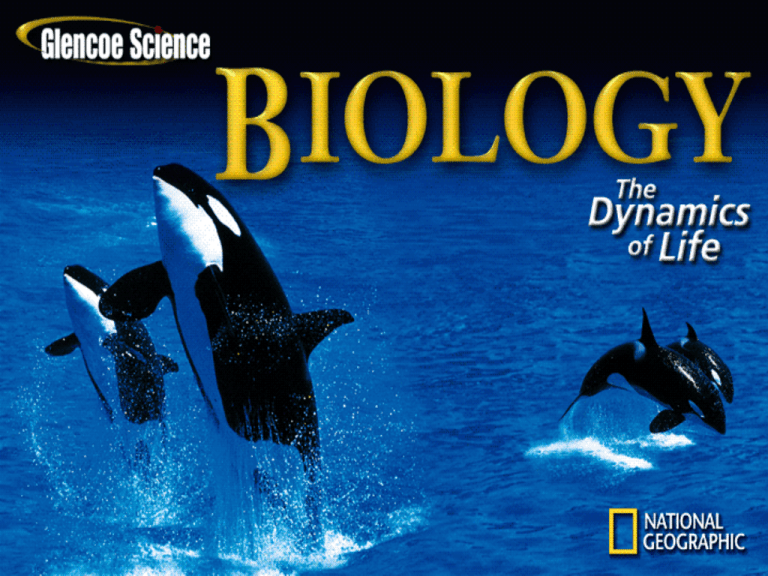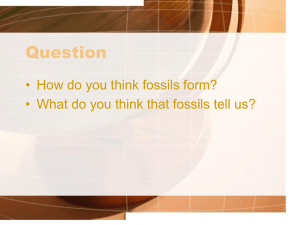Geologic Time & Origins of Life PowerPoint
advertisement

Early History of Earth What was early Earth like? • Very hot • Energy from colliding meteorites heated its surface Early History of Earth • Volcanoes spewed lava & gases, relieving pressure in Earth’s hot interior • These gases helped form Earth’s early atmosphere. Early History of Earth • ~ 4.4 billion years ago Earth cooled enough for the water in its atmosphere to condense. • This led to millions of years of rainstorms with lightning which filled depressions that became Earth’s oceans. History in Rocks • There is no direct evidence of the earliest years of Earth’s history. • The oldest rocks that have been found on Earth formed about 3.9 billion years ago. Fossils-Clues to the past • ~ 95 % of the species that have existed are now extinct Fossils-Clues to the past Types of Fossils Fossils Types Formation A trace fossil any indirect evidence left by an Any isindirect evidence Trace fossils left by an animal e.g. footprint, a trail, or a burrow. Casts Molds Petrified AmberPreserved or frozen fossils When minerals in rocks fill a space left by a decayed organism, they make a replica, or cast, of the organism. A mold forms when an organism is A mold forms when an organism is buried in sediment and then decays, leaving an empty space. Petrified-minerals penetrate and replace the hard parts of an organism. At times, an entire organism was quickly trapped in ice or tree sap that hardened into amber. • A fossil is evidence of an organism that lived long ago that is preserved in Earth’s rocks. Trace Fossils • Indirect evidence left by an animal • E.g. footprint Cast Fossils When minerals in rocks fill a space left by a decayed organism, they make a replica, or cast, of the organism. Mold Fossils A mold fossil forms when an organism is buried in sediment and then decays, leaving an empty space. Petrified Fossils • Petrified-minerals penetrate and replace the hard parts of an organism. Amber Fossils • When a whole organism gets trapped in tree sap that hardens into amber Frozen Fossils • When a whole organism is quickly trapped in ice & preserved Paleontologists-Detectives to the past • Paleontologists are scientists who study ancient life • Are like detectives who use fossils to understand events that happened long ago. Paleontologists-Detectives to the past • Paleontologists also study fossils to gain knowledge about ancient climate & geography. Fossil formation • For fossils to form, organisms usually have to be buried in mud, sand, or clay soon after they die. Fossil formation • Fossils are not usually found in other types of rock The Fossilization Process • Sediments from upstream rapidly cover the body, slowing its decomposition. Minerals from the sediments seep into the body. • Over time, additional layers of sediment compress the sediments around the body, forming rock. Minerals eventually replace all the body’s bone material. • A Protoceratops drinking at a river falls into the water and drowns • Earth movements or erosion may expose the fossil millions of years after it formed. Law of Superposition If the rock layers have not been disturbed, the layers at the surface must be younger than the deeper layers. Relative dating • The fossils in the top layer must also be younger than those in deeper layers. • Using this principle, scientists can determine relative age and the order of appearance of the species that are preserved as fossils in the layers. Radiometric dating • To find the specific ages of rocks, scientists use radiometric dating techniques utilizing the radioactive isotopes in rocks. • Recall that radioactive isotopes are atoms with unstable nuclei that break down, or decay, over time, giving off radiation. • A radioactive isotope forms a new isotope after it decays. Radiometric dating • Because every radioactive isotope has a characteristic decay rate, scientists use the rate of decay as a type of clock. • The decay rate of a radioactive isotope is called its half-life. Radiometric dating • Scientists try to determine the approximate ages of rocks by comparing the amount of a radioactive isotope and the new isotope into which it decays. Radiometric dating • Scientists use potassium-40, a radioactive isotope that decays to argon-40, to date rocks containing potassium bearing minerals. • Based on chemical analysis, chemists have determined that potassium-40 decays to half its original amount in 1.3 billion years. Radiometric dating • Scientists use carbon-14 to date fossils less than 70 000 years old. • Carbon-14 decays to half its original amount in 5730 years. A Trip Through Geologic Time • By examining sedimentary rock and fossils and by dating some of the igneous or metamorphic rocks that are found in the sequences, scientists have put together a chronology, or calendar, of Earth’s history. • This chronology, called the geologic time scale, is based on evidence from Earth’s rocks and fossils. The geologic time scale 4 Era’s • Precambrian Era • Paleozoic Era • Mesozoic Era • Cenozoic Era The geologic time scale • An era is a large division in the scale and represents a very long period of time. • Each era is subdivided into periods. The geologic time scale • The divisions are distinguished by the organisms that lived during that time interval. The geologic time scale • The fossil record indicates that there were several episodes of mass extinction that fall between time divisions. • A mass extinction is an event that occurs when many organisms disappear from the fossil record almost at once. • The geologic time scale begins with the formation of Earth about 4.6 billion years ago. Life during the Precambrian • The oldest fossils are found in Precambrian rocks that are about 3.4 billion years old. • Scientists found these fossils, in rocks found in the deserts of western Australia. • The fossils resemble the forms of modern species of photosynthetic cyanobacteria. Life during the Precambrian • The Precambrian accounts for about 87 percent of Earth’s history. • At the beginning of the Precambrian, unicellular prokaryotes—cells that do not have a membrane-bound nucleus— appear to have been the only life forms on Earth. Eukaryotes Major Events Prokaryotes Major Life Form Life evolves • About 1.8 billion years ago, the fossil record shows that eukaryotic organisms appeared. Invertebrates Life during the Precambrian Period Era Precambrian Million Years Ago 4000 3500 1800 Life during the Precambrian • By the end of the Precambrian, about 543 million years ago, multi-cellular eukaryotes, such as sponges and jellyfishes, filled the oceans. Cambrian Ordovician Conifers dominant First reptiles First seed plants First amphibians First jawed fishes First land plants First vertebrates Diversity during the Paleozoic Silurian Devonian Carboniferous Permian Paleozoic Era 543 491 443 417 354 323 Million Years Ago 290 Diversity during the Paleozoic • The largest mass extinction recorded in the fossil record marked the end of the Paleozoic. • About 90 percent of Earth’s marine species and 70 percent of the land species disappeared at this time. Triassic Era Million Years Ago 248 Flowering plants dominant First birds First flowering plants First mammals The fossils of mammals indicate that early mammals were small and mouselike. Period First dinosaurs Life in the Mesozoic Jurassic Cretaceous Mesozoic Era 144 206 Triassic Era Million Years Ago 248 Flowering plants dominant First birds First flowering plants First mammals • The middle of the Mesozoic, called the Jurassic Period, began about 206 million years ago. Period First dinosaurs Life in the Mesozoic Jurassic Cretaceous Mesozoic Era 144 206 Life in the Mesozoic • Recent fossil discoveries support the idea that modern birds evolved from one of the groups of dinosaurs. A mass extinction • The mass extinction of the dinosaurs marked the end of the Cretaceous Period about 65 mya • Some scientists propose that a large meteorite collision caused this mass extinction. Changes during the Mesozoic • The theory of continental drift, suggests that Earth’s continents have moved during Earth’s history and are still moving today at a rate of about six centimeters per year. Period Era Million Years Ago Tertiary 65 Humans evolve • The modern human species appeared perhaps as recently as 200,000 years ago. Mammals dominant The Cenozoic Era Quaternary Cenozoic Era 1.8 Spontaneous generation is disproved • Redi’s well-designed, controlled experiment successfully convinced many scientists that maggots, and probably most large organisms, did not arise by spontaneous generation. Control group Time Time Experimental group Pasteur’s experiments • In the mid-1800s, Louis Pasteur designed an experiment that disproved the spontaneous generation of microorganisms. • Pasteur set up an experiment in which air, but no microorganisms, was allowed to contact a broth that contained nutrients. Pasteur’s experiments Each of Pasteur’s broth-filled flasks was boiled to kill all microorganisms. Microorganisms soon grew in the broth, showing that they come from other microorganisms. The flask’s S-shaped neck allowed air to enter, but prevented microorganisms from entering the flask. Pasteur tilted a flask, allowing the microorganisms to enter the broth. Pasteur’s experiments • Pasteur’s experiment showed that microorganisms do not simply arise in broth, even in the presence of air. • From that time on, biogenesis, the idea that living organisms come only from other living organisms, became a cornerstone of biology. Origins: The Modern Ideas • No one has yet proven scientifically how life on Earth began. • However, scientists have developed theories about the origin of life on Earth from testing scientific hypotheses about conditions on early Earth. Simple organic molecules formed • Scientists hypothesize that two developments must have preceded the appearance of life on Earth. • 1st , simple organic molecules, or molecules that contain carbon, must have formed. • 2nd these molecules must have become organized into complex organic molecules such as proteins, carbohydrates, and nucleic acids. Simple organic molecules formed • In the 1930s, a Russian scientist, Alexander Oparin, hypothesized that life began in the oceans that formed on early Earth. • He suggested that energy from the sun, lightning, and Earth’s heat triggered chemical reactions to produce small organic molecules from the substances present in the atmosphere. Simple organic molecules formed • Then, rain probably washed the molecules into the oceans to form what is often called a primordial soup. • In 1953, two American scientists, Stanley Miller and Harold Urey, tested Oparin’s hypothesis by simulating the conditions of early Earth in the laboratory. The formation of protocells • The next step in the origin of life, as proposed by some scientists, was the formation of complex organic compounds. • In the 1950s, various experiments were performed and showed that if the amino acids are heated without oxygen, they link and form complex molecules called proteins. • A similar process produces ATP and nucleic acids from small molecules. The formation of protocells • The work of American biochemist Sidney Fox in 1992 showed how the first cells may have occurred. • Fox produced protocells by heating solutions of amino acids. • A protocell is a large, ordered structure, enclosed by a membrane, that carries out some life activities, such as growth and division. The Evolution of Cells • Fossils indicate that by about 3.4 billion years ago, photosynthetic prokaryotic cells existed on Earth. • But these were probably not the earliest cells. The first true cells • The first forms of life may have been prokaryotic forms that evolved from a protocell. • Because Earth’s atmosphere lacked oxygen, scientists have proposed that these organisms were most likely anaerobic. The first true cells • For food, the first prokaryotes probably used some of the organic molecules that were abundant in Earth’s early oceans. • Over time, these heterotrophs would have used up the food supply. The first true cells • However, organisms that could make food had probably evolved by the time the food was gone. • These first autotrophs were probably similar to present-day archaebacteria. The first true cells • Archaebacteria are prokaryotic and live in harsh environments, such as deep-sea vents and hot springs. The first true cells • The earliest autotrophs probably made glucose by chemosynthesis rather than by photosynthesis. • In chemosynthesis, autotrophs release the energy of inorganic compounds, such as sulfur compounds, in their environment to make their food. Photosynthesizing prokaryotes • Photosynthesizing prokaryotes might have been the next type of organism to evolve. • As the first photosynthetic organisms increased in number, the concentration of oxygen in Earth’s atmosphere began to increase. • Organisms that could respire aerobically would have evolved and thrived. Photosynthesizing prokaryotes • The presence of oxygen in Earth’s atmosphere probably affected life on Earth in another important way. • The sun’s rays would have converted much of the oxygen into ozone molecules that would then have formed a layer that contained more ozone than the rest of the atmosphere. The endosymbiont theory • Complex eukaryotic cells probably evolved from prokaryotic cells. • The endosymbiont theory,proposed by American biologist Lynn Margulis in the early 1960s, explains how eukaryotic cells may have arisen. • The endosymbiont theory proposes that eukaryotes evolved through a symbiotic relationship between ancient prokaryotes. The endosymbiont theory A prokaryote ingested some aerobic bacteria. The aerobes were protected and produced energy for the prokaryote. Aerobic bacteria Over a long time, the aerobes become mitochondria, no longer able to live on their own. Mitochondria Some primitive prokaryotes also ingested cyanobacteria, which contain photosynthetic pigments. Cyanobacteria The cyanobacteria become chloroplasts, no longer able to live on their own. Chloroplasts Plant cell Prokaryote Animal Cell The endosymbiont theory • Chloroplasts and mitochondria have their own ribosomes that are similar to the ribosomes in prokaryotes. • In addition, both chloroplasts and mitochondria reproduce independently of the cells that contain them. Question? What is the difference between biogenesis and spontaneous generation? Answer Spontaneous generation is the idea that life can come from nonliving material. Biogenesis is the idea that living organisms can come only from other living organisms. Question? What two molecular developments must have preceded the appearance life on Earth? Answer The formation of simple organic molecules, and the organization of simple organic molecules into complex organic molecules like proteins, carbohydrates and nucleic acids that are essential to life. Question? Who provided evidence to support Oparin’s hypothesis that life began in the oceans on early Earth? A. Sidney Fox B. Louis Pasteur C. Francesco Redi D. Stanley Miller and Harold Urey The answer is D, Stanley Miller and Harold Urey. The Record of Life • Fossils provide a record of life on Earth. Fossils come in many forms, such as a leaf imprint, a worm burrow, or a bone. • By studying fossils, scientists learn about the diversity of life and about the behavior of ancient organisms. The Record of Life • Fossils can provide information on ancient environments. For example, fossils can help to predict whether an area had been a river environment, terrestrial environment, or a marine environment. In addition, fossils may provide information on ancient climates. The Record of Life • Earth’s history is divided into the geologic time scale, based on evidence in rocks and fossils. • The four major divisions in the geologic time scale are the Precambrian, Paleozoic Era, Mesozoic Era, and Cenozoic Era. The eras are further divided into periods. The Origin of Life • Francesco Redi and Louis Pasteur designed controlled experiments to disprove spontaneous generation. Their experiments and others like them convinced scientists to accept biogenesis. • Small organic molecules might have formed from substances present in Earth’s early atmosphere and oceans. Small organic molecules can form complex organic molecules. The Origin of Life • The earliest organisms were probably anaerobic, heterotrophic prokaryotes. Over time, chemosynthetic prokaryotes evolved and then photosynthetic prokaryotes that produced oxygen evolved, changing the atmosphere and triggering the evolution of aerobic cells and eukaryotes. Question 1 Is metamorphic rock a good source of fossils? Answer No, the conditions under which metamorphic rocks form often destroy any fossils contained in the original sedimentary rock. Question 2 Why do scientists use relative dating techniques? Answer Relative dating allows scientists to compare the age and order of appearance of a fossil relative to those of the fossils appearing in the sedimentary layers above or below it. Question 3 Why do organisms that die on the surface of the ground rarely become fossils? Answer Bacteria and fungi immediately decompose organisms exposed to the air. Question 4 Why are dinosaur exhibits in museums rarely composed of real bones? Answer Minerals from sediments that covered dead dinosaurs seeped into the dinosaur’s body and eventually replaced all the body’s bone material. Question 5 Scientists use the carbon-14 isotope to date fossils that are _______ years old. A. less than 70 000 B. more than one million C. 25 000 D. more than five million The answer is A, less than 70 000. Question 6 About how many years ago do fossils indicate that photosynthetic prokaryotic cells existed on Earth? A. B. C. D. 5.4 billion years 3.4 billion years 1.8 billion years 543 million years The answer is B, 3.4 billion years. Question 7 Which forms of life developed earlier, anaerobic single-celled organisms or aerobic single-celled organisms, and why? Answer The answer is anaerobic single-celled organisms. Anaerobic single-celled organisms developed at a time when Earth’s atmosphere lacked oxygen. Aerobic organisms, which require oxygen to survive, developed later, when Earth’s atmosphere contained a supply of oxygen. Question 8 Why are archaebacteria able to survive in harsh environments where most other organisms cannot? Answer Archaebacteria can release the energy of inorganic compounds in their environment to make their food rather than rely upon other organisms for their food. Question 9 What was the importance of Earth’s ozone layer to the development of early organisms? Answer The ozone layer shielded early organisms from the harmful effects of ultraviolet radiation and enabled the evolution of more complex organisms. Question 10 In Miller and Urey’s laboratory experiment to simulate the atmospheric conditions of early Earth, what atmospheric condition did the condenser simulate? The condenser simulated rain in the atmosphere that washed organic molecules into the ocean. Electrode High voltage source Solution of organic compounds Entry for hydrogen, methane, and ammonia gases Condenser for cooling Boiling water









